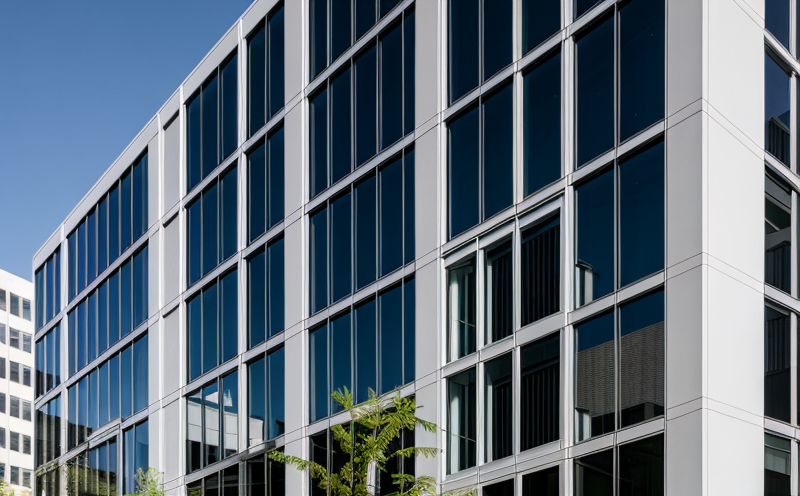ISO 12543 Laminated Glass Safety Testing
The ISO 12543 standard provides a robust framework for assessing the safety and performance of laminated glass, which is a composite material consisting of two or more layers of glass bonded together with an interlayer. This type of glass is widely used in building and infrastructure projects due to its high strength, durability, and ability to withstand impact without shattering into sharp fragments.
Our laboratory specializes in conducting comprehensive ISO 12543 laminated glass safety tests that adhere strictly to the international guidelines outlined by ISO. These tests are essential for ensuring public safety, especially in areas where large glass surfaces are present such as skylights, windshields, and facades.
The testing process involves several key steps including the preparation of test specimens which must be representative of the actual glass being tested. Once prepared, these samples undergo rigorous mechanical loading tests designed to evaluate their ability to resist various forms of stress and impact without failure. The results provide critical data on both structural integrity and safety performance.
Our team uses advanced equipment tailored specifically for this type of testing, including high-capacity testing machines capable of simulating real-world conditions such as wind loads or impacts from flying debris during severe weather events like hurricanes or tornadoes. By subjecting these specimens to controlled environments that mimic potential hazards, we can accurately assess how well they would perform under actual usage scenarios.
The importance of accurate and reliable testing cannot be overstated when it comes to protecting public safety in buildings and infrastructure projects involving laminated glass components. Our facility offers not only state-of-the-art facilities but also experienced professionals who are committed to providing clients with precise, objective results that meet or exceed all relevant standards.
Understanding the nuances of ISO 12543 compliance is crucial for any organization involved in designing or constructing buildings and structures containing laminated glass elements. Our comprehensive testing services ensure that every aspect of safety regulations is considered during development stages so potential risks are identified early on before they become costly issues later down the line.
Scope and Methodology
The scope of ISO 12543 laminated glass safety testing encompasses a wide range of parameters aimed at evaluating both structural integrity and impact resistance. Below is an overview of some key aspects covered by our comprehensive testing protocols:
| Parameter | Description |
|---|---|
| Impact Resistance | Evaluates the ability of laminated glass to withstand impacts from objects such as hailstones or flying debris. |
| Bending Strength | Determines how much bending stress a sample can endure before breaking. |
| Edge Deflection | Measures the degree of deflection at edges after applying specified loads. |
| Deformation | Assesses the amount of permanent deformation post-testing to ensure structural soundness. |
| Edge Bonding | Verifies that layers are properly adhered along all edges according to specifications. |
The methodology employed in our testing laboratory follows closely with the procedures specified within ISO 12543. This includes precise preparation of test specimens, calibration of equipment, application of standardized loading conditions, and thorough examination of results against internationally accepted criteria.
Benefits
Conducting ISO 12543 laminated glass safety testing offers numerous advantages for organizations involved in construction or manufacturing activities utilizing this material. Some key benefits include:
- Enhanced Public Safety: Ensures compliance with strict safety standards, reducing risk of injury from broken glass fragments.
- Regulatory Compliance: Meets all necessary requirements set forth by relevant authorities ensuring legal adherence for your projects.
- Improved Product Quality: Provides valuable insights into areas needing improvement, leading to enhanced product quality and reliability.
- Cost Efficiency: Early identification of potential issues saves time and money compared to addressing problems post-installation.
- Informed Decision Making: Accurate testing data informs better decision-making processes regarding design choices, material selection, and project planning.
By leveraging our expertise in ISO 12543 laminated glass safety testing, your organization can gain a competitive edge by ensuring superior quality while maintaining strict compliance with industry standards. This ultimately translates into increased trust among clients and stakeholders, fostering long-term relationships built on reliability and excellence.
Use Cases and Application Examples
Laminated glass finds applications across various sectors including commercial buildings, residential complexes, transportation hubs, and public infrastructure projects. Here are some specific use cases where ISO 12543 testing plays a crucial role:
- Commercial Buildings: Large windows and curtain walls often incorporate laminated glass for its aesthetic appeal and enhanced security features.
- Residential Complexes: Multi-story apartment buildings frequently use this type of glass in balconies, terraces, and external façades to ensure robust protection against environmental elements.
- Transportation Hubs: Airports, train stations, and bus terminals may install laminated glass for their skylights or entrance doors due to frequent foot traffic and harsh weather conditions.
- Parking Structures: Parking garages frequently employ this material in ceilings and walls because it provides excellent insulation properties alongside its safety advantages.
In each of these scenarios, ISO 12543 testing ensures that the chosen laminated glass meets all necessary safety requirements before installation. This not only protects end-users but also helps architects and engineers design safer structures from the ground up.





